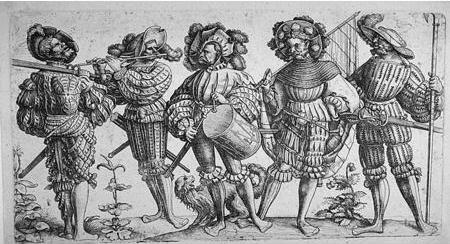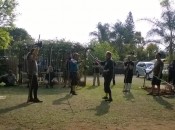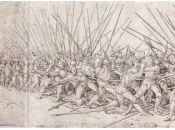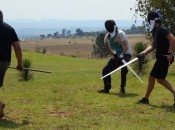
Something a little less technical today, as I work on surviving the winter cold and the last of my marking. I’ll try get another chunk of Thibault’s longsword and a piece on Meyer’s First Device out over the weekend.
Over the last few years, I’ve been a fairly regular visitor to HEMA events in Europe, which normally results in two types of conversations. Firstly, there is the “South Africa? Oh wow! I didn’t think anybody did HEMA in Africa” conversation, and secondly there is the “If you are here doing this good stuff, why don’t we see more South Africans?”. Anja and I are obviously interesting anomalies, one way or the other, but most people don’t have much insight into the reality of doing HEMA at the tip of Africa. Here’s some thoughts about running a HEMA club in South Africa, which are probably relevant for HEMA anywhere.
What surprises me somewhat is how much Europeans know about South Africa, and how little they know as well. People can reel of city names and a lot of history, but have very little context for this information. Though Johannesburg and Cape Town are well-known, very few people know that these two cities are 1500km apart, with very little in between (the bulk of South Africa is sparsely populated).That’s the distance from Paris to Warsaw! That makes it a two hour flight between the two cities, and, if you are not careful, a return ticket to Cape Town can be 30-40% of the cost for a return ticket to Europe! This distance makes coordinating HEMA events between my group in Pretoria (MACS) and the group in Cape Town (Table Mountain HEMA), well, difficult. I did nearly 4000km of driving in a week taking Anja and myself down to the Cape for a workshop and tournament; though we did some sightseeing and wine-tasting, it certainly was very rushed and hard work.
Similarly, most people have very little concept of the racial and financial demographics. We’re a country about twice the size of France with half the population (52 million people on the last census), about 10% of whom (6 million people) have European forebearers. Therefore, I’m not unusual in being a white English-speaking South African, and I’m also not going to know so-and-so from Kenya. We’re a first-world country in many respects (highways, infrastructure, tertiary industry), with a third-world labour base of poorly educated rural/semi-urban people to support. Financially, we have very low living costs (prime steak will cost you less than 10 euros in a restaurant), and our salaries are decent, probably better than in many Eastern European countries. However, our international buying power isn’t great once you factor in shipping and the exchange rate.
So, what does the scene look like? Well, to put it bluntly, there isn’t much of one. Table Mountain HEMA in Cape Town and MACS in Pretoria stand as the only formal HEMA groups. There are a number of BOTN/IMCF groups in Johannesburg, and an SCA outpost in Cape Town, and then Durban Sword and Shield on the South Coast, which I’d describe as a BOTN group. Originally I started MACS in Johannesburg before moving 60km north to Pretoria, but MACS Johannesburg folded after a few years for a variety of reasons. We do get some interest in starting another group in Johannesburg, but nothing has ever come of it.
What does this mean for getting a HEMA group up and going? Well, there are definitely difficulties:
- Population density means that travelling time between urban areas is high. Our cities are spread out, sprawling masses of one storey bungalows- Johannesburg, for instance, covers a distance of nearly 60km north-south, and 100 km east-west. We have no mass transit (or very little until recently), so travelling takes time. This makes supporting a new HEMA class in another part of the same city or country time-consuming and expensive.
- Equipment is often prohibitively expensive. To buy and import a Regenyei feder, along with a SPES jacket, mask and gloves, is going to cost R10000, which is a at least twice if not three times the minimum wage for many workers. Those of us who have money and run clubs tend to have spares, but most of my club members have to save for a longish period of time to afford their first sword.
- Climate makes most protective equipment impractical anyway. With temperatures for most of the year above 30 degrees C at midday, and winter temperatures often in the high teens- low 20s, we really don’t want to wear a lot of padding. Thus, we tend to train minimalistic, with t-shirts and track-pants the norm even in sparring. This tends to give heavy emphasis to control, though we do add extra armour for tougher tournaments.
- Though there is a big population group derived from European stock, only a small group of people have much interest or knowledge of European history and culture. We don’t have castles or Renn Faires, and making in-roads into popular culture is extremely slow.
- We’re very isolated internationally, and most people don’t travel often or at all. This makes Anja and myself the receptacles of all things HEMA for most people, a god-like status that can be a bit embarrassing at times. Some of the older students have taken workshops with visiting instructors when I’ve brought them out, but, in the main, all knowledge rests within the club.
In many respects I just happened to be in the right place at the right time in order to make MACS the 15 year old success story it is now. Though we started small, I was able to travel during my PhD and now during my work as a university lecturer (a better paid one than many European lecturers), and gain the experience needed to get things going. MACS ranges between 10 and 20 people most of the time, and we teach mainly German longsword and Italian rapier, with a little bit of many other systems. However, many other groups have failed, so here’s some thoughts on how to make a group work.
These comments are probably fairly universal:
- A group needs an organiser, and the venue should be near the organiser’s residence and/or work. Basically, the less effort it is for the organiser, the more will be organised. When the organiser has to travel a long distance, then things tend to go wrong.
- Find an undercover venue as soon as possible. Though we have generally good weather, a couple of missed classes due to rain will rapidly splinter a group. School halls, scout halls, church halls, and sports club are all good targets.
- People tend to turn up if they are making a financial commitment, so even if you are not paying for a hall, charge fees. You can use it for equipment and save up for club stuff.
- Weekend meetings are better if you are drawing people from a wide area. However, weekday evenings (twice a week) tend to draw in a more regular crowd. Firstly, there are fewer events like family gatherings during the week, and secondly it becomes part of the daily schedule. We found we had more regular attendance when we moved to the week. Two sessions a week also allows faster progress and possibly several different systems.
- If you want to make things work, you are going to have to put some money into equipment first. A batch of synthetic swords and some masks are pretty essential, and you need to have those before you can convince people to buy their own. If there is an established club, you may be able to borrow such equipment to start with.
- Preparation: people come to classes if a class is prepared. Even if there is only a rough plan, there must be a plan, both for the immediate class and in the long term. People make a firmer commitment when they see where they are going, and how they are going to get there.
- Fight! You need to make regular sparring time, either in every class, or at regular monthly intervals. This is the fun stuff, the pinnacle of the art, and this is what keeps bringing people back. However, you also need to learn how to coach sparring, so it doesn’t frustrate people (another post entirely).
- Ask for help- there are people around who can offer one session a month, or will come down and help for one month. Learn from these people, but forge your own route.
Anyhow, these are my thoughts on what needs to happen to broaden HEMA in South Africa. I’ve been attempting to drive the local scene a little more this year, offering regular tournaments open to many people, as well as offering classes to anybody willing to have me. Comments welcome!





